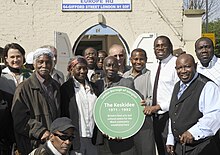|
Keskidee CentreThe Keskidee Centre, or Keskidee Arts Centre, was Britain's first arts centre for the black community, founded in 1971.[1][2] Located at Gifford Street in Islington, near King's Cross in London, it was a project initiated by Guyanese architect and cultural activist Oscar Abrams (1937–1996)[3] to provide under one roof self-help and cultural activities for the local West Indian community. Its purpose-built facilities included a library, gallery, studios, theatre and restaurant.[4] The Keskidee became a hub for African and Afro-Caribbean politics and arts, and for years was the only place in London that produced black theatre,[5] developing its own vibrant drama company and attracting both a black and white audience.[6] HistoryIn 1971, Guyanese-born architect and cultural activist Oscar Winston Abrams (1937–1996), who had settled in Britain in 1958,[7] bought a run-down Victorian mission hall[8] from the Shaftesbury Society for £9000[2] and transformed it into the Keskidee Centre,[9] which came to provide "a unique and hugely influential cultural and political environment for the black community throughout the 1970s and early-1980s."[2] The community centre's name and logo derived from the keskidee bird native to Guyana and elsewhere in the Caribbean.[9][10] The Keskidee Theatre workshop was founded in 1971, with a full-time drama company dedicated to black theatre, under the artistic direction of African-American Rufus Collins, who had originally come to Britain on tour with The Living Theatre.[11][12] Among other professional actors, directors, and playwrights it attracted were Yvonne Brewster, Anton Phillips, Howard Johnson, Jimi Rand (Say Hallelujah),[13] Edgar Nkosi White (Lament for Rastafari, 1977; Les Femmes Noires/The Black Women),[14][15] T-Bone Wilson (Jumbie Street March; Body and Soul, 1974),[16] Pat Maddy (Gbana Bendu, 1973),[17] who at one time was Director of Drama,[18] Yemi Ajibade, and Lindsay Barrett.[9][4] Productions of Derek Walcott's Pantomime,[19] Wole Soyinka's The Swamp Dwellers (1975)[20] and Lennox Brown's Throne in an Autumn Room (1973)[21] were also staged.[22] Nigerian artist and sculptor Emmanuel Taiwo Jegede was also an artist-in-residence;[23] his son Tunde Jegede, born in 1972 and now a composer and virtuoso kora player, has credited the Keskidee Centre with initiating and nurturing his earliest appreciation of African diaspora culture.[24] Errol Lloyd was also brought in by Abrams to be artist-in-residence (1974–75).[4] As an indication of the significant role played by the Keskidee Centre in nurturing, supporting and celebrating Black visual artists, Diaspora Artists quotes from the Preface to the journal Savacou, issue 9/10, written by John La Rose and Andrew Salkey: "At the time of writing, the most recent medium session, held at the Keskidee Centre, on Friday 10th March 1972, was A Tribute to Ronald Moody, a historical exposition, illustrated with slides, of Jamaican sculptor, arranged and presented by Errol Lloyd, the Jamaican painter."[10] Linton Kwesi Johnson was the Keskidee's first paid library resources and education officer, and his work at the centre featured in Franco Rosso's 45-minute documentary film Dread, Beat an' Blood, produced in 1979.[25][10] It was at the Keskidee Centre that Johnson developed dub poetry, a staged version of his poem "Voices of the Living and the Dead" being produced by Lindsay Barrett there in 1973, with music by the reggae group Rasta Love.[2] The venue was also used for community meetings and events by the Caribbean Artists Movement.[2] On 10 December 1974, Angela Davis spoke at the Keskidee Centre, while she was in London to attend a rally in support of South African political prisoners.[26] Up-and-coming bands such as Misty in Roots and Steel Pulse also played at Keskidee, and in 1978 Bob Marley used the centre to make a video (in which a seven-year-old Naomi Campbell took part along with other children) for his song "Is This Love?"[2][27][28][29] The Keskidee Centre ran into financial difficulties in the 1980s, and closed in 1991. The building was subsequently taken over by the Christ Apostolic Church.[6] Oscar Abrams died on 15 February 1996, aged 58.[2] LegacyIn 2009, The Keskidee was the subject of a BBC Radio 4 programme based on oral history interviews conducted by Alan Dein as part of the King's Cross Voices project.[30][31]  On 7 April 2011, to celebrate the 40th anniversary of the opening of the Keskidee Centre,[32] an Islington Council heritage green plaque was unveiled on the building, at the time a church, by David Lammy and former resident artist Emmanuel Jegede.[5][33][34][35][36] On the night of 8 March 2012, the building was ravaged by fire.[6][37] The police treated the blaze as suspicious, and the investigation was closed a month later after a Scotland Yard spokesman announced that the police had "exhausted all lines of inquiry".[38] References
Further reading
External links
|